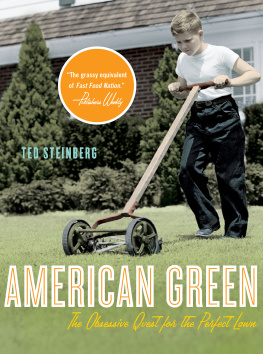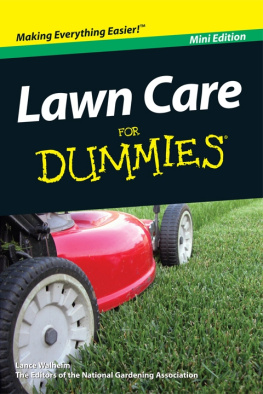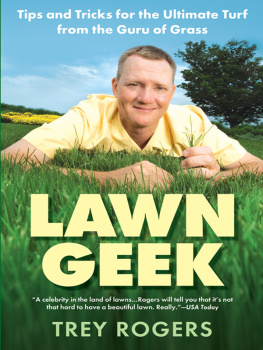beautiful no-mow yards

beautiful no-mow yards
50 amazing lawn alternatives
Evelyn J. Hadden

Copyright 2012 by Evelyn J. Hadden. All rights reserved.
Frontispiece by Saxon Holt.
Published in 2012 by Timber Press, Inc.
The Haseltine Building
133 S.W. Second Avenue, Suite 450
Portland, Oregon 97204-3527
timberpress.com
2 The Quadrant
135 Salusbury Road
London NW6 6RJ
timberpress.co.uk
Printed in China
Library of Congress Cataloging-in-Publication Data
Hadden, Evelyn J.
Beautiful no-mow yards: 50 amazing lawn alternatives/Evelyn J. Hadden.1st ed.
p. cm.
Includes bibliographical references and index.
ISBN 978-1-60469-238-9
1. GardensDesign. 2. Ground cover plants. I. Title. II. Title: Fifty amazing lawn alternatives.
SB473.H25 2012
635.964dc23
2011020832
A catalog record for this book is also available from the British Library.
To the many fabulous, fascinating gardeners who
shared their stories with me and invited me into their
gardens. Not just those who made it into these pages,
but every one of you. It has been an inspiration to
meet you all and see (or just hear about) the magical
places you have made and loved. Your connections with
your gardens feed my hope for humanity.

foreword
For decades, gardeners on this side of the Atlantic have emulated the vast, perfect lawns of English estate-owners, who flaunted their wealth by devoting their land to an unproductive use. Weve coddled and fussed with our lawns in hopes of creating something that meets the high expectations of golfers, all too often by following the advice in ubiquitous ads telling us to green up our lawns with repeated applications of products. But finally were beginning to see that we dont have to conform to that crazy standard anymore. People are starting to challenge local laws and homeowner association rules that require the growing of lawn or, even worse, that lawns be green all summerand theyre winning those challenges.
Slowly were learning about the environmental damage done in the name of the Great American Lawnthe wasted water, the fertilizers running off into waterways, the lawn pesticides harming everything they touch: pollinators, soil, humans, and pets. Were seeing connections between disappearing wildlife and the vast acreage weve devoted to a single plant that provides virtually nothing for wildlife. And then there are those fume-spewing mowers and blowers.
I had a lawn for many years myself, but eventually all those negatives plus being bored to tears by lawn care inspired me to remove it alldone! Well, not so easy. To replace it with what? Researching lawn replacement usually yielded just one solution: a big meadow. Where were the inspiring design ideas for regular-sized yards? Or the array of plants that had proven tough and sustainable in spots that were once lawn? Or some realistic advice about how to maintain them? Despite my decades of gardening, I had no idea how to convert my lawn to something that might really work.
But in my search for alternatives I did find someone whod been speaking and writing about lawn reduction for a decade already, and it was Minnesota rabble-rouser Evelyn Hadden. So I enlisted her and a few others excited about this subject, and we formed the Lawn Reform Coalition to spread the word about natural lawn care, better types of grasses, and ways to reduce or eliminate lawns altogether.
But the coalitions website (lawnreform.org) cant showcase the whole range of alternatives to the bad old ways of lawns and lawn care, with stories about real gardeners whove created gardens that are healthier and far more satisfying. To fill that void, we now have Beautiful No-Mow Yards. Its packed with photos (many by the renowned Saxon Holt) of real gardens, including my own, where I endured several failures in the search for effective lawn alternatives. If only this book had existed a few years ago!
In her book Evelyn has used the same inclusive approach adopted by the Lawn Reform Coalitionavoiding finger-pointing and the simplistic one-solution-for-everyone advice we find in so much information about sustainable gardening. Instead, she gently leads readers to make peace with their land by growing plants that connect them with nature, and by creating spaces to gather, play, and calm their overworked souls.
Beautiful No-Mow Yards is an important book not just because its so darn definitive, but because its for such a large audience: eco-minded non-gardeners trying to reduce their lawn, beginning gardeners who want gardens filled with glorious plants, and experienced gardeners like myself who are taking their gardens into unknown territory. I predict that first youll enjoy this book, then youll really enjoy the new life it helps you create just outside your back door. Your front door, too. Go for it!
Susan Harris, co-founder of the team blog GardenRant and founder of the Lawn Reform Coalition

preface
as a nature lover who also happens to enjoy gardening, I have been avidly studying, experimenting with, and having conversations about lawn alternatives ever since I bought my first house (and lawn). During the year in which I assembled the photos and wrote the text for this book, I came to appreciate anew the diverse personalities of gardens and their gardeners, and the stories that both contain.
A garden is a dynamic art form that depends on people for its ongoing life. The art does not exist merely within the garden but is also held and nurtured within the soul of the gardener; a real and powerful part of any garden is the relationship between it and the people who cherish it.
I have seen the heart go out of gardens whose gardener moved away. I have felt the amplified energy of gardens that are loved and cared for by a group of people. There are so many ways that a place can be enlivened by connections with people that I hesitate to say, as I once did, that land left to its own devices will be more full of life than land that is intensively cared for by people.
And that gives me hope that, in the future, our landscapes will be as varied and alive and artful and touching as the people who shape them. All that we need to do is rediscover the many wonderful things that can happen when you take a serious interest in your landscapes individual character and its good health. These revelations are what this book is really about.
acknowledgments
Many thanks to those who have contributed important ideas and inspiration to this book through their photos: Kelly Broich, Lucy Dinsmore, Jeff Epping, Billy Good-nick, Diane Hilscher, Lindsay Rebhan, Michael Schumacher, Lisa Weidema, and most especially to the poetic and philosophical Saxon Holt.
My deep appreciation goes to the many supportive and insightful people who have helped with thinking, organizing, and generating ideas and solutions for this book: Jason Doran, Fran Kiesling, Billy Goodnick, Karen Graham, Susan Harris, Diane Hilscher, Angela Hohler, Saxon Holt, Susan Morrison, Erik James Olsen, Nancy Schumacher, Carmen Simonet, Ginny Stibolt, Paula Westmoreland, and Peggy Willenberg. I am particularly indebted to dear friends Julie Kostroski and Kristin Matthews Long, and to my amazing, admirable sister Sherilyn, for pivotal conversations. Also my sincere thanks to the gardeners and designers whose stories fill these pages. All have provided crucial details and corrections; the text is much better for their gentle feedback and helpful suggestions.
Next page












